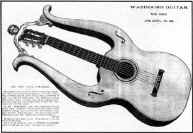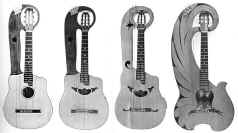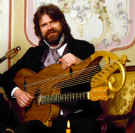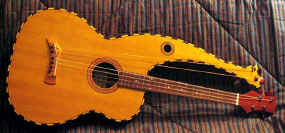|
|
"Knutsen-esque"
Instruments |
|
|
|
"Knutsen-esque"
Instruments |
|
|
by Gregg Miner, as part of |
 |
Hollow-arm guitars and mandolins by other makers
Just how unique were Knutsen’s "One-Arm" harp guitars?
I’m not going to go into a full history of harp guitars (another fun project for my retirement!), but I still believe (as first stated in my 1995 CD booklets) that Knutsen was the first builder in America to create the hollow-arm-extension harp guitar. Update 1/19/03: Darn it! Technically, the Birrer patent added below scoops Knutsen's patent. Others had done so previously in Europe, most notably Schenck (pictured below). And of course, lyre guitars, with two hollow arm extensions were common much earlier. Harp and lyre mandolins with hollow arms have also occurred in Europe and the States – and some of these pre-date Knutsens.
I offer up the instruments below to show the many variations on this theme throughout many countries and time periods. Some may have influenced Knutsen, others may have been influenced by Knutsen, and some may have simply been "convergent evolution."
NOTE: Dyer
harp guitars and mandolins are
addressed separately here:
Dyer
harp guitars
Dyer harp mandolins

|

|

|

|
| French lyre guitars
from the 1700s. As far as I know, these "true" lyre guitars never had extra strings. The two arms were
considered an aesthetic enhancement, more so than a real tonal improvement.
(left image copyright Francois Charle, right image copyright Gregg Miner) See also the Harpguitars.net Organology Lyre Guitars Gallery. |
Lyre guitars died out about
200 years ago - except for the occasional experiment. This highly
unusual Washburn lyre guitar was offered in their 1895 catalog.
(right image copyright MOMI) http://www.themomi.org/museum/index2.html |
||
|
...and a somewhat similar, unusual, 12-string lyre guitar. From Mugwumps Online: "There was the Lyric
Guitar Co, founded in 1907 at Kansas City, MO by Joseph H. Behee to
manufacture and sell a patented lyre-shaped guitar." According to the late husband of the owner,
"the company made these between 1907 and 1917. His understanding is that there are only 5 of these in the U.S."
The owner, Carol Colonna, of Hollywood, California, is offering this
guitar for sale (8/15/03). Additional photos and information available.
Contact her through the Knutsen Archives. (images copyright
Gregg Miner)
NOTE (2012): This instrument was almost certainly made much later, in the late 'fifties. See also the Harpguitars.net Organology Hollow Arm Guitars Gallery. |

|

|

|

|
| Lyre mandolins (or mandolira) were
made just after 1900 in Italy and America - much later than the
similar lyre guitars. This is my Calace.
(image copyright Gregg Miner) |
A wonderful variation with dragons
on the arm tips! Sold at an obscure musical instrument auction years ago. |
And of course, the
most famous Lyre Mandolin of all!
Orville Gibson's trademark.
(images copyright Frank Ford) - more photos
at: |
|
|
See also the Harpguitars.net Organology Related Stringed Instruments Gallery. |
|||

|

|

|

|
| Chitarra-lyras by Luigi Mozzani,
from the 1900's. These instruments were directly inspired by Schenck's.
Mozzani seems to have been as creative as Knutsen, though with a
completely different Italian aesthetic. Wonderful stuff!
(images copyright Arts & Crafts Press) |
Two existing Mozzanis. (sold by Lorenzo Frignani) (images copyright Lorenzo Frignani) http://www.frignanilorenzo.com/default_uk.htm |
Mozzani, in turn, inspired Mario
Maccaferri,
who created the famous Selmer "Django" guitars in the
thirties. Here is the harpe version, from
the terrific book, The Story of Selmer Maccaferri Guitars by
Francois Charle. www.rfcharle.com (image copyright Francois Charle) |
|

|

|

|

|
|
| This gorgeous instrument,
commissioned by
Beppe Gambetta, is featured on David Grisman's fascinating Traversata
CD. The usual
extensive liner notes discuss and picture the unique Settimo Gazzo harp guitars on which this
exact replica by Antonello Saccu was based.
(image copyright Beppe Gambetta) http://www.pangea.it/gambetta/beppe.html |
Two similar instruments by unknown
makers. (left image copyright Mario F. Vecco, available for sale. |
And the original instrument by Settimo Gazzo - played by the master himself, Pasquale Taraffo. Some virtuoso gut-string harp guitar playing on these rare 78 recordings from the '20s & '30s released on CD by sugarmusic.com. |
|
|

|

|

|

|
|
| The interesting story of the 1898 Hagberg patent
(# 29,666) is told in From Harp Guitars to the New Hawaiian Family by Noe
& Most. The hollow arm on this Knutsen rip-off actually had an opening
like a trumpet. Apparently, none were made, as it was a patent
infringement. Too bad - would've been something to see!
Click here for Patent text. |
This intriguing instrument is
patent # 518,775 from April 24, 1894 - two years before Knutsen's
first patent. Invented by a John B. Birrer of Newton, Kansas, this
hollow-armed guitar now supercedes Knutsen's "One-Arm Guitar" as
the first of this concept in America. Note the similarity of the hollow head (with 2nd soundhole) and tuners to those of Schenck's instruments above. |
Several other American makers also
tried a version of Knutsen's hollow-armed harp guitar - presumably after
the patent had expired. This is a "Majestic," from the gorgeous
coffee table book of the collection of the late Scott Chinery.
(image copyright Miller Freeman Books) |
This is an interesting one! A
hollow, very Knutsen-esque harp arm, and 12 strings on the neck.
The abrupt arm termination is original. Any ideas?
(image copyright Sid Glickman) |
And an even stranger looking
"12-string" harp guitar (6 dbl-courses on the neck, plus
sub-bass strings).
(image from ebay) |
See also the Harpguitars.net Organology Harp Guitars, Form 3a,b & c Galleries.

|

|

|
|
| Another patent story
told in the Noe/Most book is that of the Ernest Livermore mandolin. After
signing as a Knutsen patent witness, Livermore immediately stole Knutsen's
hollow-arm extension idea - applying it (pretty badly) to a bowl-back
mandolin and violin. He clearly wasn't an instrument builder, and
apparently never bothered to have any of the instruments made (or, rather,
attempted). However, this patent (# 26,424) apparently prevented Knutsen from designing and building his own harp mandolins until 1910. |
This is pretty
interesting! One Claude Gaskin received a patent (# 552,116) for his "mandolin-harp" on
Dec. 31, 1895. Was Knutsen aware of it? Possibly not, as Gaskin was in Pennsylvania. This one would also seem to have prevented Knutsen from building his harp mandolins for 14 years. Click here for Patent text. |
And guess who was also
in Pennsylvania? C.F.Martin. This unbelievably rare and wonderful
instrument, according to Michael Holmes, was made by the Martin factory, and looks almost exactly like Gaskin's
patent. In June, 2004, I found a message post describing the Martin-signed
label, dated Sept, 1893.
(image copyright and courtesy Michael Holmes of Mugwumps Online) |
|

|
Click here for Patent text and similar "harp-violin" patent. | ||
| What then to make of this one? Patented (# 52,539) by one George J. McVey of Lincoln, Nebraska on Oct. 8, 1918, it's clearly a knock-off of the harp-mandolins Knutsen had been building since about 1910. Knutsen's labels also claimed his mandolin was patented, though there is no record yet found of this. So how did McVey manage this Design Patent? He boldly claims his "new, original, and ornamental Design for Musical Instruments." For some reason, the term of this patent is only 3-1/2 years. | This patent (# 45,566) was granted April 7, 1914, and was again, "a new, original, and ornamental Design for Musical Instrument" by Catello Longobardi, of Schenectady, New York. Notice the tuners, again similar to the Schenck guitars above. This is a variation on the existing European mandolins (shown below), with a unique small bowl added to the back. |
See also the Harpguitars.net Organology Related Stringed Instruments Gallery.
| Weissenborns and other "Knutsen-esque" Hawaiians:
This area is way beyond my means. Refer to the many instruments
in the Noe/Most book. There are many more wonderful instruments out there –
perhaps Tom Noe will do an update or Ben Elder will produce his anticipated
book. |
||
 Experimental
Hawaiian Guitar Experimental
Hawaiian Guitar |
||
 |
Not a Weissenborn copy but a
circa 1900 German guitar-lute, with a curiously familiar shape!
(image from ebay)
|
|
|
Like the mandolin above, this Almcrantz guitar has a distinctive "Weissenborn-esque" shape (not quite as pronounced as the mandolin). The label is dated 1895. Not much is known of Almcrantz, who built guitars and mandolins from ca. 1895-1905. (images copyright and courtesy and anonymous donor) |
||
There is currently a veritable plethora of new makers making copies or
variations of the Dyer Symphony harp guitar. Also a few of the style that John
Doan plays. But no true Knutsen copies yet!
Here are some Knutsen-inspired or Knutsen-reminiscent creations:

|
This Harp-Requinto, made by Mike Doolin for Muriel
Anderson features a rather Knutsen-esque bass headstock. Mike writes: "The guitar neck is very short scale, about 22.9", and tuned G to G in guitar intervals, G D Bb F C G top to bottom. It's just like you capoed a 66 cm classical neck at the 3rd fret. Then the 7 harp strings proceed down the G minor scale from there: F Eb D C Bb A G. "The damper arm (not shown - check Mike's photos on Link - ingenious! - GM) attaches magnetically to the side, with two brass registration pins to keep it lined up. The damper arm is then suspended above the strings under internal spring tension. Muriel can damp all 7 harp strings with her right wrist while still playing the 6 strings on the neck. |
|
"It's all nylon string, with a 9-fan bracing system co-designed with Jeff
Elliott. The harp arm and neck block are supported with epoxy-graphite
reinforced wood braces to support the 190 lbs of string tension. The neck
features my Adjustable Neck Angle System. There's a B-Band pickup system under
both bridge saddles. "The harp tuners are Schaller steel-string M6 Mini, with brass caps over the posts to increase their diameter to 10mm like classical tuners. Each harp string has a sharping mechanism to raise it a half-step, so you can get any of 8 keys from 2 flats to 5 sharps. "Woods include an Engelmann spruce top, Madagascar rosewood back and sides, Spanish cedar neck and harp head, and boxwood binding. The harp arm is inlaid with a Celtic Knot and Dove inlay by Bill Nichols." (image copyright Mike Doolin) See additional photos here. |
|
| Many other new hollow-armed harp guitar designs can be seen on the Harpguitars.net Organology Harp Guitars, Form 3a Gallery. | |

|

|

|
|
| A few years back,
Michael Dunn started making copies of the Knutsen harp uke. Like Knutsens, no two of Michael's are alike! See: http://www.michaeldunnguitars.com/ |
(Inv #MDU25 & MDU31) (image
copyright Elderly Instruments) |
And another - I
can't believe this instrument is only $750 at Mandolin Brothers! (image copyright Stan Jay/Mandolin Bros) |
|

|
|||
| In 2003, Michael completed two new additions to what has become his own "New Hawaiian Family"! To scale L-R are: Tenor harp guitar, tenor harp ukulele and standard harp uke (he's also made a concert size). Scale length of the tenor guitar is just over 21", the tenor uke is 17", and the standard uke is 13-3/8". | Michael
says: "The tenor harp guitar has a soundboard of Douglas Fir. The back and sides are of
Padauk. The bass arm supports 2 extra bass strings. The bridge is of Yew wood and the binding is from Boxwood and
Ebony." I say: What a riot! A completely cool new instrument, totally in keeping with Knutsen's own ideas and style (I'm sure if Knutsen had lived another decade, he would have built one of these!). (images
copyright Michael Dunn) |
Of the tenor harp ukulele.
Michael says: "...has a Cedar soundboard and Pernambuco back and sides. The
binding is of Boxwood and Ebony and the headplates and bridge covering are of Ebony
with its sapwood." The owner, John Bushouse, who comissioned the instrument, shares additional photos and info HERE. Again, Knutsen should have built one of these! |
|
| And speaking of harp ukes ... I wouldn't call this Knutsen-inspired (rather, it looks like those strange Maurer harp guitars!), but wanted to include it here, since it's so unique. Additional information (not in English) and a whole "making of" page can be found at: http://www.crane.gr.jp/more/2neck-Uke/ (image copyright Makoto Tsuruta) |
| Wouldn't you know it - a month after my "definitive article" on harp ukuleles came out in the Ukulele Occasional (Feb, 2004), I discovered two more wonderful new instruments by a couple of "under-the-radar" makers. The best part is, both ukes have extra strings! | |
| Koji Sugiura, of Japan says that his harp uke, called "Air," was inspired by a Knutsen Harp Guitar and made in tribute to Michael Hedges & Morihiko Yasuda. He built this one-of-a-kind instrument for himself in February, 2003. This one has bass and trebles, for a total of 10 strings! He tunes the standard strings G,C,E,A and the trebles an octave above that. The basses are A and D. Interesting how he combines a Gibson F-style-shaped headstock with the Knutsen hollow arm. Note also the biased nut and bridge. A complete "making of" page can be found here. (image copyright Koji Sugiura) |  |
| Steve Wise of Texas custom-built this instrument for customer. Part Knutsen, part Dyer, part Wise, it features 4 bass strings along with the standard 4. Steve also made a striking Dyer-inspired harp guitar. See more of both here. (image copyright Steve Wise) |  |
See also the Harpguitars.net Organology Related Stringed Instruments Gallery.
|
If you enjoyed this page, or found it useful for research, please consider supporting Harpguitars.net so that this information will be available for others like you and to future generations. Thanks!
|
[Biographical]
[Instruments]
[Historical
Photos]
[Credits]
[FAQ]
[Bibliography]
[Updates]
[Links]
[Contact]
[Home
(Knutsen Archives)] [Home
(Harpguitars.net)]
All Site Contents Copyright © Gregg Miner, 2002, 2003, 2004, 2005,2006,2007,2008,2009. All Rights Reserved.
Copyright and Fair Use of material and use of images: See Copyright and Fair Use policy.